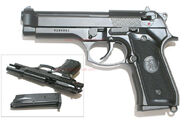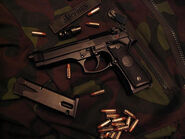The M9 handgun, formally Pistol, Semiautomatic, 9mm, M9, is a 9mm pistol of the U.S. military adopted in the 1980s. It is essentially a Beretta 92F (later the 92FS), built to U.S. military specifications.
It won a competition in the 1980s to replace the M1911A1 as the primary handgun of U.S. armed forces, beating out many other contenders. Some other models have been adopted to a lesser extent (namely the M11 Pistol), and older, or different, models remain in use in certain niches. It officially entered Army service in 1990 according to the official Army website. It was scheduled to be replaced under an Army program, the Future Handgun System (FHS), which was merged with the SOF Combat Pistol program to create the Joint Combat Pistol (JCP). In early 2006, the JCP was renamed Combat Pistol (CP), and the number of pistols to be bought was drastically cut back.
The M9 has been modified as the M9A1, adding, among other things, a tactical rail for the attachment of lights, lasers, and other accessories to the weapon. The U.S. Marines have ordered large numbers of M9A1 pistols in the last year. Additionally, a contract for 70,000 M9 pistols was signed in 2006 by the U.S. military.
Technical description[]
A locked breech, semi-automatic, single-action/double-action recoil-operated pistol, the M9 uses a 15-round staggered magazine with a reversible magazine release button that can be positioned for either right- or left-handed shooters.
The M9 is used with the M12 Holster (Part of the Beretta UM84 Holster System), though other holsters are often used.
Adoption: JSSAP, XM9, and XM10 trials[]
Under the Joint Service Small Arms Program which was run by the U.S. Air Force, a number of 9 mm pistol designs were trialed in the late 1970s to find a replacement for the M1911. The 9 mm round was selected for compliance with NATO standardization. In 1980, the Beretta 92S-1 design was chosen over entries from Colt, Smith & Wesson, various Fabrique Nationale de Herstal models, the Star M28, and Heckler & Koch models. The result, however, was challenged by the Army and new tests were to be done (this time run by the Army rather than the Air Force). In the new test all the pistols were rejected, and in a second test a year later they were all rejected again. Another year later, in 1984, the trials started again with updated entries from S&W, Beretta, SIG-Sauer, H&K, Walther, Steyr, and FN. Beretta won this competition but there was a new trial, the XM10 competition, in 1988. This resulted in two different trials that were more limited, but resulted in the Beretta design being kept (with an update to it happening during the same time frame).
Concerns and Controversy[]
Prior to its widespread adoption by the US military, questions were raised in a Government Accounting Office report regarding a number of incidents where slide failures caused injuries to Naval Special Warfare personnel and were later observed in additional testing. These failures included both military and civilian Beretta models with very high round counts and provoked a modification in the M9 design to prevent slide failure from causing injuries. These incidents also resulted in the Naval Special Warfare Forces seeking "an improved 9mm weapon that (1) can withstand extensive training firings, (2) has a long service life, and (3) provides reliable functioning in life-threatening situations." (GAO NSAID-89-59 p. 9). This resulted in the adoption of a variant of the SIG-Sauer P226.
Another concern is the large circumference grip coupled with a long double-action trigger reach. Users of this system may have difficulty firing accurately, often forcing the firer to adopt an off axis grip to reach the trigger in double action mode throwing rounds off target. This is considered one reason for the adoption of the M11 Pistol.
Marine Security Guard students perform rapid-fire exercises on the Department of State pistol qualification course Feb. 4 as part of their MSG graduation requirementA final concern with the design is the placement of the de-cocker/safety on the slide. In stressful situations, this control is placed out of the normal reach of the firing hand and can be left in the "on" position resulting in a failure to fire under stress.
An April 2002 presentation by the Natick Soldier Center presented by LTC Charlie Dean and SFC Sam Newland reported on lessons learned from M9 use in Afghanistan (such as use during Operation Anaconda):
- Soldiers had problems with the magazine springs becoming too slack.
- 25% felt that the ammunition needed to be more powerful and of higher manufactured quality.
- 50% reported rust and corrosion problems, especially with the barrel.
- 63% reported confidence in the M9.
Many of the magazines (including the springs) issued for use with the M9 are not produced by Beretta, but are made by aftermarket manufacturers such as Mec-Gar, Checkmate Industries, and Airtronic Services, Inc. Many firearms experts maintain that the only reliable magazines to use with any pistol are those produced by the pistol's manufacturer (also called "OEM", or "Original Equipment Manufacturer"). Mec-gar and Checkmate Industries are both Original Equipment Manufacturers for Beretta.

